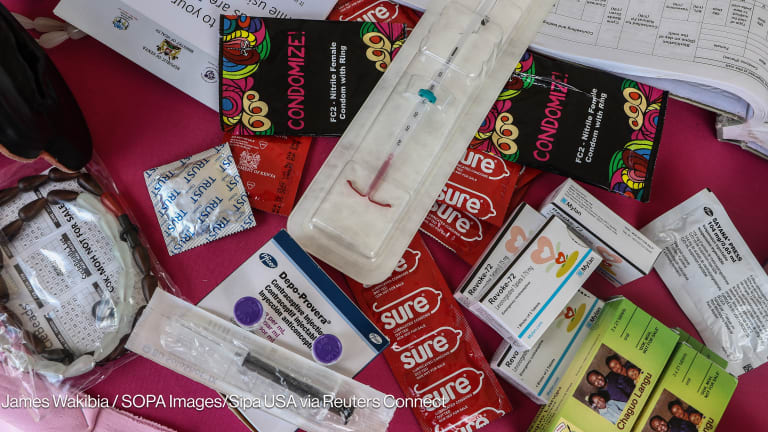
The world is stumbling toward a contraceptive crisis.
Why? Because the money isn’t available and bottlenecks hit the very contraceptives that are urgently needed.
It’s quite simple why this should be prioritized. Meeting women’s contraceptives needs means offering them more possibilities. It’s about choice. Having the right to choose your own future promotes convenience and acceptability. If you can access your choice of contraception at any health facility or over the counter, this put the minds of women and their partners at ease.
But, the success of family planning programs can only be achieved if the necessary supplies are accessible, available and affordable to meet the growing demand for contraceptives.
Here are four ways to improve in family planning programs.
1. Increase funding for contraceptives
Projections show one of the largest shortfalls in financing for family planning that we have seen since it was prioritized at the London Family Planning Summit in 2012.
The funding gap is estimated at $273 million, according to UNFPA Supplies — the world’s leading supplier of reproductive health supplies — by 2020. The availability of contraceptives relies on funding from donor countries and sufficient investments from national governments. The impact of this contraceptive funding crisis will be far-reaching — contraceptive stockouts, interrupted supply chains, and an inability to guarantee contraceptive security.
It’s ironic that the global funding shortfall for contraceptives comes at a time when family planning is high on the global agenda, with over 80 governments pledging renewed commitment to family planning through the global partnership Family Planning 2020.
2. Strengthen fragile health systems
Even if demand for contraception is matched with sufficient support and funding, without strengthening fragile and failing health systems there will be many who still won’t be reached with contraceptives. Health systems for supplies are often interrupted and weak, leading to faulty forecasting and miscalculations.
You can’t solve anything without a commitment to deliver on promises. Political commitment — and greater financial commitment — is desperately required at every step of the supply chain to get contraceptives to those who want them.
The leadership and commitment of government to adopt new approaches to reduce the needs of women all over the world is paramount. Governments are critical agents in securing and offering contraceptives as a human right through their health systems, together with their partners.
For that to be sustainable and effective, domestic resources should be dedicated to contraception, fostering an enabling environment to ensure sexual and reproductive health and rights for women and girls everywhere, even down to the last mile. The prioritization of sexual and reproductive health services within national and district-level governments is just as important as the support of international stakeholders.
3. Take action to tackle blocks
We call on governments to be accountable to the health and well-being of their citizens. Equally, civil society has a critical role to play in advocating for sustained funding for contraceptives, and accountability at all levels.
This really is a crisis. We all must be aware of the urgency, before family planning gains realized through decades of hard work are lost.
How to fix the supply issue? Follow Uganda’s example
A great example of how to tackle the supply issue to reach the last mile can be found in Uganda.
Currently, the private sector provides 60 percent of contraceptive services. But there’s a bottleneck in contraceptive supplies: At times sitting in warehouses, ports or at a central clinic, contraceptives were not reaching users that needed them. These delays in arrivals skewed forecasting for future contraceptives and caused stockouts of requested contraceptive methods.
To tackle this issue, in 2011 — through support from Advance Family Planning, the International Planned Parenthood Federation and the Ministry of Health in Uganda — Reproductive Health Uganda, our member association, developed a pioneering strategy to ensure the consistent and efficient delivery of supplies to and from private sector facilities
The alternative distribution system returned forecasting control to local organizations familiar with the needs of reproductive health supply users. Sustained advocacy over six months led to a memorandum of understanding between the government of Uganda and the private sector’s Uganda Health Marketing Group to formalize the alternative distribution strategy.
This partnership was critical in validating roles and responsibilities to ensure the program continues, commodities remain available and Uganda is better able to meet the demand of its contraceptive users.
Read more about Uganda’s alternative distribution strategy here and join the global call to action in this petition to world leaders to address the global contraceptive crisis here.
A number of areas are clear for governments, donors and civil society to take action to ensure that they can deliver to women and young people. Success of the Sustainable Development Goals can only be realized if women, men and young people have access to contraception.
Bottlenecks and blocks need to be tackled, which means procurement must be addressed through strengthening supply systems, and better coordination of supply efforts throughout a country. In the end this will offer a greater method mix of contraceptives. After all, people should be able to choose a method that is right for them, and at the time when they need it.
From an individual perspective, we must work with governments to make contraceptives affordable. This can be done through encouraging national governments to eliminate out-of-pocket expenses, taxes and levies placed on supplies toward affordable and accessible contraceptives.
4. Manage funding for better innovation
A final point, which we see demonstrated time and time again, is the management of existing funding. Family planning programs must be adequately funded, with a separate budget line in the national and (if applicable) sub-national budget. Funds should be released on time, in full, and spent appropriately.
This is not impossible. Financing innovations for supplies owned and locally led by those working in-country are key to securing contraceptives for their citizens.
Governments’ abilities to foster close partnerships with civil society, the private sector and communities, as well as engaging effectively with the international community and the global commercial market, is paramount to achieving sustainable development, and the realization of right to choice.
The time to act is now.
Family planning has improved the lives of hundreds of millions of people. Its overall contribution to poverty reduction, gender equality, public health, development and human rights must not be lost or denied. While access to contraception is often taken for granted in the developed world, millions of women in the developing world still have an unmet need. We must ensure access to all women, men and young people — regardless of their geography — and ensure that all have the right to access the same benefits.
Making Markets Work is an online conversation to explore what’s being done to make global health care markets accessible to people at the base of the pyramid. Over 10 weeks, Devex and its partners — The Abraaj Group, Philips and Population Services International — will amplify the discussion around effective health financing, analyze key challenges blocking universal market access in the health care supply chain, and explore the key strategies to make markets more effective. Join us as we look at this important issue, and share your thoughts by tagging #MakingMarketsWork and @Devex.
Read more on Making Markets Work:
► How to build on what works to improve health markets
► Results-based financing shows a new way of doing health care
► How nonprofits can improve their results with commercial techniques
► Addressing the data deficits that hold back health care systems
► Taking the pulse of health markets: Challenges and strategies









